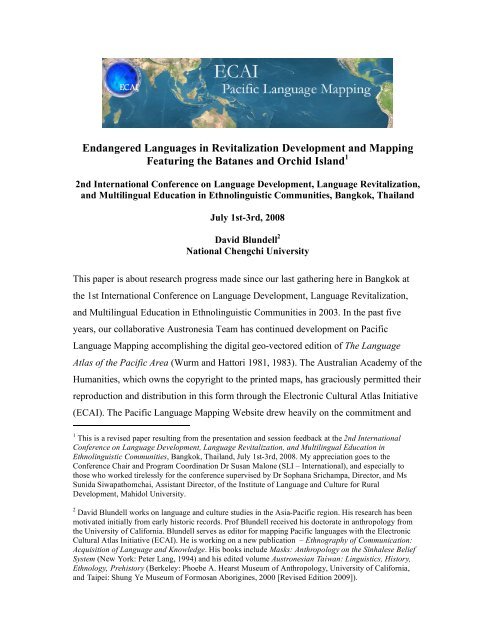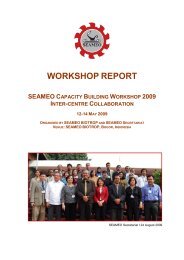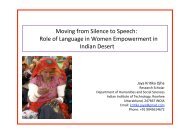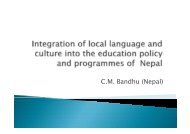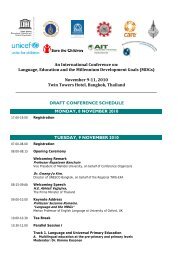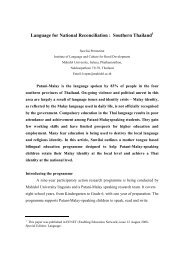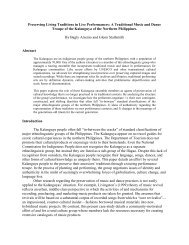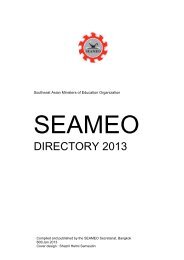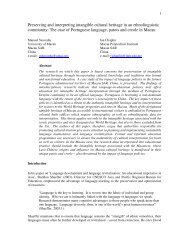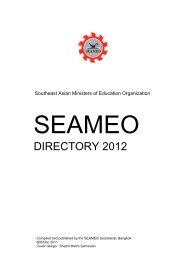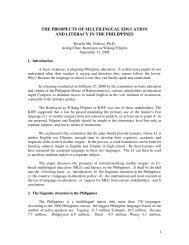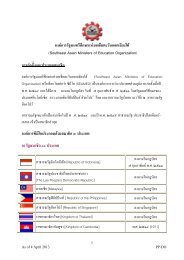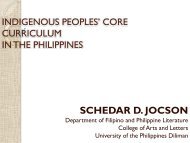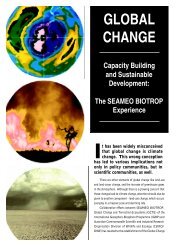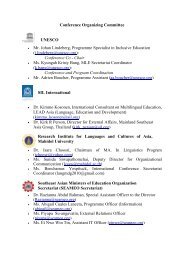Endangered Languages in Revitalization Development ... - seameo
Endangered Languages in Revitalization Development ... - seameo
Endangered Languages in Revitalization Development ... - seameo
Create successful ePaper yourself
Turn your PDF publications into a flip-book with our unique Google optimized e-Paper software.
<strong>Endangered</strong> <strong>Languages</strong> <strong>in</strong> <strong>Revitalization</strong> <strong>Development</strong> and Mapp<strong>in</strong>g<br />
Featur<strong>in</strong>g the Batanes and Orchid Island 1<br />
2nd International Conference on Language <strong>Development</strong>, Language <strong>Revitalization</strong>,<br />
and Multil<strong>in</strong>gual Education <strong>in</strong> Ethnol<strong>in</strong>guistic Communities, Bangkok, Thailand<br />
July 1st-3rd, 2008<br />
David Blundell 2<br />
National Chengchi University<br />
This paper is about research progress made s<strong>in</strong>ce our last gather<strong>in</strong>g here <strong>in</strong> Bangkok at<br />
the 1st International Conference on Language <strong>Development</strong>, Language <strong>Revitalization</strong>,<br />
and Multil<strong>in</strong>gual Education <strong>in</strong> Ethnol<strong>in</strong>guistic Communities <strong>in</strong> 2003. In the past five<br />
years, our collaborative Austronesia Team has cont<strong>in</strong>ued development on Pacific<br />
Language Mapp<strong>in</strong>g accomplish<strong>in</strong>g the digital geo-vectored edition of The Language<br />
Atlas of the Pacific Area (Wurm and Hattori 1981, 1983). The Australian Academy of the<br />
Humanities, which owns the copyright to the pr<strong>in</strong>ted maps, has graciously permitted their<br />
reproduction and distribution <strong>in</strong> this form through the Electronic Cultural Atlas Initiative<br />
(ECAI). The Pacific Language Mapp<strong>in</strong>g Website drew heavily on the commitment and<br />
1 This is a revised paper result<strong>in</strong>g from the presentation and session feedback at the 2nd International<br />
Conference on Language <strong>Development</strong>, Language <strong>Revitalization</strong>, and Multil<strong>in</strong>gual Education <strong>in</strong><br />
Ethnol<strong>in</strong>guistic Communities, Bangkok, Thailand, July 1st-3rd, 2008. My appreciation goes to the<br />
Conference Chair and Program Coord<strong>in</strong>ation Dr Susan Malone (SLI – International), and especially to<br />
those who worked tirelessly for the conference supervised by Dr Sophana Srichampa, Director, and Ms<br />
Sunida Siwapathomchai, Assistant Director, of the Institute of Language and Culture for Rural<br />
<strong>Development</strong>, Mahidol University.<br />
2 David Blundell works on language and culture studies <strong>in</strong> the Asia-Pacific region. His research has been<br />
motivated <strong>in</strong>itially from early historic records. Prof Blundell received his doctorate <strong>in</strong> anthropology from<br />
the University of California. Blundell serves as editor for mapp<strong>in</strong>g Pacific languages with the Electronic<br />
Cultural Atlas Initiative (ECAI). He is work<strong>in</strong>g on a new publication – Ethnography of Communication:<br />
Acquisition of Language and Knowledge. His books <strong>in</strong>clude Masks: Anthropology on the S<strong>in</strong>halese Belief<br />
System (New York: Peter Lang, 1994) and his edited volume Austronesian Taiwan: L<strong>in</strong>guistics, History,<br />
Ethnology, Prehistory (Berkeley: Phoebe A. Hearst Museum of Anthropology, University of California,<br />
and Taipei: Shung Ye Museum of Formosan Aborig<strong>in</strong>es, 2000 [Revised Edition 2009]).
hard work of the Comput<strong>in</strong>g Centre of Academia S<strong>in</strong>ica and of the Spatial Data Projects<br />
at the Griffith Asia Pacific Research Institute, Griffith University, to scan and digitize<br />
most of the maps as a seamless Web based digital atlas.<br />
Our project traces its history to the Conference on Austronesian Studies <strong>in</strong><br />
Taiwan, October 1997 held at the University of California, Berkeley. Lewis Lancaster<br />
gathered the scholars for an orientation at the campus for the Central Asia/Silk Road<br />
projects and to discuss the Pacific Neighborhood Consortium (PNC) established <strong>in</strong> the<br />
early 1990s (see Berkeley Image Database Project 1991; Wasley 1995) and the formation<br />
of the Electronic Cultural Atlas Initiative (ECAI). It was mentioned that our group could<br />
possibly work on an atlas for the Austronesian Language Family. The people attend<strong>in</strong>g<br />
considered this to be an <strong>in</strong>trigu<strong>in</strong>g idea. At the 1998 PNC meet<strong>in</strong>gs, at Academia S<strong>in</strong>ica,<br />
Taipei, the concept grew along with the digital museum and library programs develop<strong>in</strong>g<br />
at National Taiwan University and Academia S<strong>in</strong>ica.<br />
Our ECAI Digital Language Atlas of the Pacific Area <strong>in</strong>cludes vectorized datasets<br />
developed from the orig<strong>in</strong>al 47-leaf atlas of language boundaries. The geographic content<br />
of shorel<strong>in</strong>es and language boundaries of the paper maps were digitally traced <strong>in</strong>to a<br />
seamless atlas us<strong>in</strong>g as a reference the Digital Chart of the World (DCW). The DCW is a<br />
comprehensive 1:1,000,000 scale vector base map of the world designed to meet the<br />
needs of pilots and aircrews <strong>in</strong> medium-and low-altitude navigation and to support<br />
military operational plann<strong>in</strong>g, <strong>in</strong>telligence brief<strong>in</strong>gs, and other needs. The primary source<br />
for this data set is the Operational Navigation Chart (ONC) series produced by the United<br />
States, Australia, Canada, and the United K<strong>in</strong>gdom and issued by the US Defense<br />
Mapp<strong>in</strong>g Agency (DMA, an ancestor of the present National Geospatial-Intelligence<br />
Agency). The data currency varies from place to place, rang<strong>in</strong>g from the mid 1960s to the<br />
early 1990s and <strong>in</strong>cludes numerous thematic layers <strong>in</strong>clud<strong>in</strong>g country boundaries,<br />
urbanized areas and po<strong>in</strong>ts, altitude, land cover, cultural landmarks, transportation<br />
structure, and other features. The GIS version is viewable us<strong>in</strong>g the TimeMap dynamic<br />
map browser. See: http://ecai.org/austronesiaweb/pacificlanguages.htm.<br />
The work reported here built directly on these prior achievements. The Website<br />
and its maps were extensively developed <strong>in</strong> conjunction with the follow<strong>in</strong>g objectives:<br />
Fieldwork for provid<strong>in</strong>g map layers relevant to the languages and cultures of the Batanes<br />
2
and Orchid Island; and, especially, the <strong>in</strong>dicator symbols -- like p<strong>in</strong>s on a paper map --<br />
referr<strong>in</strong>g to all the cultural evidence (texts, audio, photos, material culture, etc.) that we<br />
and our collaborators can locate <strong>in</strong> libraries, museums, and bibliographies (Blundell et al.<br />
<strong>in</strong> press).<br />
The <strong>in</strong>terface is also to show contextual <strong>in</strong>formation, with map layers for the<br />
geography of languages, political boundaries, topography, and other <strong>in</strong>formation.<br />
Kimberly Carl, Ray Larson, Jeanette Zerneke, and others created this <strong>in</strong>teractive atlas at<br />
UC Berkeley, us<strong>in</strong>g TMW<strong>in</strong> tools developed by the TimeMap Project, University of<br />
Sydney (Johnson 1998; Zerneke and Johnson 2002; Buckland et al. 2004; Zerneke 2005).<br />
Collaboration is important for the project to research contemporary issues of endangered<br />
languages and conservation. Procedures are based on UNESCO guidel<strong>in</strong>es for tangible<br />
and <strong>in</strong>tangible cultural heritage and UNESCO’s The Babel Initiative for Internet-based<br />
record<strong>in</strong>g of languages, dissem<strong>in</strong>ation, and revitalization processes.<br />
When research<strong>in</strong>g language maps, several dist<strong>in</strong>ctions come <strong>in</strong>to play. Chart<strong>in</strong>g a<br />
language could refer to “mapp<strong>in</strong>g communications” as a field theoretical approach (i.e.,<br />
ethnography of communication, media conveyance) to the ways and means people utilize<br />
<strong>in</strong> formulat<strong>in</strong>g and transferr<strong>in</strong>g ideas and <strong>in</strong>formation. Another mapp<strong>in</strong>g purpose could be<br />
<strong>in</strong> the conceptual “reference to space and spatial directions” given <strong>in</strong> a language (see<br />
Senft 1997). Here, language mapp<strong>in</strong>g is concerned with the production of an “atlas of<br />
languages” with boundaries. Serious physical and theoretical problems occur when<br />
def<strong>in</strong><strong>in</strong>g a language and its dialects and when attempt<strong>in</strong>g to mark the geographic limits of<br />
a language. Individual languages are referred to by various names, often by a name that<br />
did not orig<strong>in</strong>ate with the speakers of that language, but was selected from field studies or<br />
<strong>in</strong> previous accounts of the literature referr<strong>in</strong>g to the language. Then, as the language<br />
speakers move spatially, or as the language becomes a dialect, the supposed language<br />
shifts position on a map. Also, speakers adopt other languages, becom<strong>in</strong>g bil<strong>in</strong>gual or<br />
multil<strong>in</strong>gual, challeng<strong>in</strong>g the established geo-census data.<br />
The ECAI tools are not def<strong>in</strong>itive. They are meant to be facilitat<strong>in</strong>g a progression<br />
of Web-based technologies for researchers to utilize. Let’s say by select<strong>in</strong>g an island –<br />
what is provided <strong>in</strong>cludes: geo-referenced boundaries such as coasts, rivers, estuaries,<br />
satellite images, topographies, place names, and roughly cultural zones dist<strong>in</strong>guished by<br />
3
languages. Researchers want<strong>in</strong>g more def<strong>in</strong>itive <strong>in</strong>formation will provide their own data<br />
as layers to the atlas format. Early cartography could be applied dat<strong>in</strong>g back hundreds of<br />
years <strong>in</strong>clud<strong>in</strong>g legendary data based on stories. Or recent case studies of micro-<br />
household language ethnography could be applied of socio-l<strong>in</strong>guistic significance to the<br />
multil<strong>in</strong>gual capabilities of <strong>in</strong>dividual speakers. Th<strong>in</strong>k of ECAI atlases as bullet<strong>in</strong> boards<br />
with layered components of technologies provided to assist data providers. It’s expected<br />
that ECAI technologies will migrate with advances of collaborative researchers provid<strong>in</strong>g<br />
the latest <strong>in</strong>teractive tools for data <strong>in</strong>put and storage.<br />
Critical questions 3 have emerged on the worth and value of mapp<strong>in</strong>g languages.<br />
<strong>Languages</strong> are dynamic and shift<strong>in</strong>g with mobile populations of multil<strong>in</strong>gual speakers.<br />
When consider<strong>in</strong>g a “map” traditionally, it appears static and dated to the time of its<br />
cartographic research and publication. The ECAI concepts of mapp<strong>in</strong>g are based on the<br />
flow<strong>in</strong>g processes <strong>in</strong> the flux of dynamic chang<strong>in</strong>g data. Researchers have their own<br />
objectives for the development of atlases.<br />
Atlas research data hold<strong>in</strong>gs could be made public and/or kept as a personal<br />
bullet<strong>in</strong> board with password entry for <strong>in</strong>ternal data storage and utility. It’s a dynamic<br />
research suite of tools provided by a consortium of <strong>in</strong>terested parties.<br />
Current Project on the Batanes and Orchid Island<br />
Our current phase of the project deals with the language and culture of the<br />
Batanes Islands -- the smallest and most northern island prov<strong>in</strong>ce of the Philipp<strong>in</strong>es<br />
(Moriguchi 1998) and Orchid Island (Lan-yu, or Irala) adm<strong>in</strong>istrated by Taitung County,<br />
Taiwan, and. These islands straddle the Bashi Channel. The Bashiic cultural arena<br />
<strong>in</strong>cludes the Yami speakers of Lan-yu <strong>in</strong> the north and the Batanic speakers south<br />
between Taiwan and the Philipp<strong>in</strong>es. The Yami as well as most people of the Batanes<br />
3 Appreciation is given to the people who critiqued this presentation at the 2nd International Conference on<br />
Language <strong>Development</strong>, Language <strong>Revitalization</strong>, and Multil<strong>in</strong>gual Education <strong>in</strong> Ethnol<strong>in</strong>guistic<br />
Communities and the edit<strong>in</strong>g consultants of this paper.<br />
4
claim orig<strong>in</strong>s from Itbayat and Batan islands. The project <strong>in</strong>cludes field research and<br />
participation by Yu-hsiu Lu, ethnomusicologist; Chien-hsiang L<strong>in</strong>, documentary<br />
filmmaker; Andrew Limond, specializ<strong>in</strong>g <strong>in</strong> boat construction; Christian Anderson,<br />
anthropologist; and others. The documentation and presentation of the research is<br />
<strong>in</strong>tended to demonstrate the use geographical <strong>in</strong>formation systems facilitat<strong>in</strong>g local and<br />
scholarly <strong>in</strong>put.<br />
The Batanes Islands<br />
The semi-tropical Batanes group of islands is the northernmost prov<strong>in</strong>ce of the<br />
Philipp<strong>in</strong>es. The islands comprise an archipelago located between 121° 45' to 122° 15'<br />
east longitudes, and at 20°15' north latitude. The Batanes Islands are closer to Taiwan<br />
than to the northern end of Luzon. Of the ten volcanic islands compos<strong>in</strong>g the prov<strong>in</strong>ce,<br />
three of the largest islands are <strong>in</strong>habited: Batan (7,000 hectares) and Sabtang (1,600<br />
hectares), and Itbayat (9,000 hectares). A fourth island, Ivuhos, ly<strong>in</strong>g about a 1.5<br />
kilometers from Sabtang, has some families rais<strong>in</strong>g cattle. The other, un<strong>in</strong>habited islands<br />
are Yam’i, North, Mavudis, Siayan, Di-nem, and Dequey. The prov<strong>in</strong>ce has a total island<br />
area of 230 sq. km, the smallest <strong>in</strong> the Philipp<strong>in</strong>es. There seasons <strong>in</strong>clude: rayun<br />
(summer), March to May, amian (w<strong>in</strong>ter) November to February. Kachachimuyen is the<br />
ra<strong>in</strong>y season for the other months with sudden warmer conditions (dekey a rayun) dur<strong>in</strong>g<br />
two weeks between September and October.<br />
The language and people of the Batanes are known as Ivatan. The languages of<br />
Lan-yu, Itbayat, Batan, and Sabtang are mutually <strong>in</strong>telligible with dialects between<br />
islands and with<strong>in</strong> islands. The language of the Batanes is classified as Austronesian,<br />
Malayo-Polynesian, Western Malayo-Polynesian, Northern Philipp<strong>in</strong>e, Bashiic-Central<br />
Luzon-Northern M<strong>in</strong>doro, Bashiic, and Ivatan (see ethnographic research on the Batanes:<br />
Alonzo 1960, Madrigal 1983, Benedek 1987, Hidalgo 1996, and Castor 1998).<br />
The Batan Island people probably orig<strong>in</strong>ated from Luzon sometime just over a<br />
thousand years ago. The prov<strong>in</strong>ce has six municipalities with the towns Ivana, Uyugan,<br />
Mahatao, and Basco (or Vasay), the prov<strong>in</strong>cial capital, on Batan Island and two other<br />
island-wide municipalities of Sabtang and Itbayat.<br />
5
Archaeological explorations <strong>in</strong> the islands of Batan, Sabtang, Ivuhos, and Itbayat<br />
have identified five types of sites: (1) ijang, defense rampart structures on promontory or<br />
highland areas; (2) nakavajayan, abandoned habitations; (3) Nephrite jade workshops and<br />
other Neolithic sites of pottery and slate blades from Taiwan dat<strong>in</strong>g from 2500-4500 BP<br />
(Szabo, et al. 2003, Bellwood and Dizon 2005); (4) 16th century burials marked by<br />
stones <strong>in</strong> a boat shape; and (5) jar burials. (Later burials were done by the methods of the<br />
Dom<strong>in</strong>ican friars from the Spanish adm<strong>in</strong>istration).<br />
Orchid Island (Lan-yu, or Irala) 4<br />
Orchid Island is “Lan-yu” <strong>in</strong> Mandar<strong>in</strong>, from the wild orchids (Tuberolabium kotoense)<br />
found there. Irala is a Batanes language name for the island. Another name Botel Tobago<br />
appears on early European maps express<strong>in</strong>g a trade item or shape of the island (e.g., a<br />
tobacco bottle used by sailors). Its language classification is Austronesian, Malayo-<br />
Polynesian, Western Malayo-Polynesian, Northern Philipp<strong>in</strong>e, Bashiic-Central Luzon-<br />
Northern M<strong>in</strong>doro, Bashiic, and Yami. The island is north of the Batanes archipelago<br />
separated by the Bashi Channel. It is an island of 45 sq. km, about 80 km southeast of<br />
Taitung City, Taiwan, and is populated by 4,250 Yami speakers <strong>in</strong>habit<strong>in</strong>g six villages. In<br />
this strongly matriarchal society, women grow taro <strong>in</strong> complex irrigated fields<br />
surround<strong>in</strong>g villages. The people claim ancestry to the Batanes, and most probably<br />
migration was from Itbayat beg<strong>in</strong>n<strong>in</strong>g about seven hundred years ago. Yami is the<br />
designation of the language mutually <strong>in</strong>telligible among the six villages with Lang Dao<br />
hav<strong>in</strong>g a dialect variation. Men construct plank boats for fish<strong>in</strong>g (Teng 1985). Traditional<br />
homes are built semi-underground. From March to June, fly<strong>in</strong>g fish are harvested <strong>in</strong> the<br />
Black Current (or Kuroshio Current [from Japanese, black stream] flow<strong>in</strong>g south to the<br />
north).<br />
The term Yami for the language and culture of the Orchid Island people came<br />
from a Japanese ethnologist, Niaoju Lungtsang. The term was reta<strong>in</strong>ed dur<strong>in</strong>g the<br />
Japanese occupation of Taiwan (1895-1945) and to the present. Yami speakers recently<br />
have questioned this term applied to them. In the past few decades also called themselves<br />
4 For bibliography see, Chiang 2004.<br />
6
Tao (mean<strong>in</strong>g people) as part of a resurgence of ethnic self-identity after the lift<strong>in</strong>g of<br />
martial law (that had kept the govern<strong>in</strong>g status quo <strong>in</strong> place from 1947 to 1987) enabl<strong>in</strong>g<br />
a renaissance of ethnic choices. However, Orchid Island people identify themselves by a<br />
specific locality, essentially their village name. The six village communities are Ye You,<br />
Yu Jen, Hong Tou, Ye Y<strong>in</strong>, Dong Q<strong>in</strong>, and Lang Dao. Op<strong>in</strong>ions are divided as to<br />
reta<strong>in</strong><strong>in</strong>g “Yami” or select<strong>in</strong>g “Tao” for self-identity -- neither of which is completely<br />
satisfactory to the local people who are divided about the choices (Limond 2002).<br />
Fieldwork<br />
To date, from 2004 to 2006 our team members have visited and conducted fieldwork on<br />
the Batanes and Orchid Island for <strong>in</strong>terview<strong>in</strong>g people and mapp<strong>in</strong>g local language and<br />
culture. These ethnological surveys provided materials to create Web pages featur<strong>in</strong>g<br />
historic maps, geographic <strong>in</strong>formation systems (GIS) vectored base maps for public<br />
research utilization, archaeological sites, place names, zones of land use, photographs,<br />
topography, and l<strong>in</strong>ks to video <strong>in</strong>terviews of oral histories, legends, and songs. Local<br />
people helped with the project with an <strong>in</strong>terest to conserve their cultural heritage as a<br />
Web based utility resource.<br />
Discussion<br />
Our projects are collaborative efforts and provides a model for comb<strong>in</strong><strong>in</strong>g digital versions<br />
of older pr<strong>in</strong>ted language map with the collection of data on contemporary languages<br />
areas <strong>in</strong> order to exam<strong>in</strong>e language and culture dynamics visually (see Blundell 2000a,<br />
2000b, 2003; Blundell and Zerneke 2002; Blundell and Buckland 2004; Blundell et al. <strong>in</strong><br />
press). Supported by UC Berkeley endowment funds we are (1.) add<strong>in</strong>g more and more<br />
diverse local cultural resources, <strong>in</strong>clud<strong>in</strong>g photos, sound record<strong>in</strong>gs and video record<strong>in</strong>gs<br />
of <strong>in</strong>terviews, language samples, legends, and oral history, and material culture,<br />
bibliographic resources; (2.) provid<strong>in</strong>g fuller annotations, explanations, and metadata for<br />
materials collected, especially video record<strong>in</strong>gs; and, (3.) connect<strong>in</strong>g with the Batanes<br />
Diaspora <strong>in</strong> California. We are now shar<strong>in</strong>g our work with Batanes islanders liv<strong>in</strong>g <strong>in</strong> the<br />
United States and seek their help <strong>in</strong> enrich<strong>in</strong>g our resources.<br />
7
When research<strong>in</strong>g language maps, several dist<strong>in</strong>ctions come <strong>in</strong>to play. Chart<strong>in</strong>g a<br />
language could refer to “mapp<strong>in</strong>g communications” as a field theoretical approach (i.e.,<br />
ethnography of communication, media conveyance) to the ways and means people utilize<br />
<strong>in</strong> formulat<strong>in</strong>g and transferr<strong>in</strong>g ideas and <strong>in</strong>formation. Another mapp<strong>in</strong>g purpose could be<br />
<strong>in</strong> the conceptual “reference to space and spatial directions” given <strong>in</strong> a language (see<br />
Senft 1997). Here, language mapp<strong>in</strong>g is concerned with the production of an “atlas of<br />
languages” with boundaries.<br />
Serious physical and theoretical problems occur when def<strong>in</strong><strong>in</strong>g a language and its<br />
dialects and when attempt<strong>in</strong>g to mark the geographic limits of a language. Individual<br />
languages are referred to by various names, often by a name that did not orig<strong>in</strong>ate with<br />
the speakers of that language, but was selected from field studies or <strong>in</strong> previous accounts<br />
of the literature referr<strong>in</strong>g to the language. Then, as the language speakers move spatially,<br />
or as the language becomes a dialect, the supposed language shifts position on a map.<br />
Also, speakers adopt other languages, becom<strong>in</strong>g bil<strong>in</strong>gual or multil<strong>in</strong>gual, challeng<strong>in</strong>g the<br />
established geo-census data.<br />
Bibliography<br />
Alonzo, Julio G.<br />
1966 The Batanes Islands. Manila: Acta Manilana UST Research Center.<br />
Bellwood, Peter<br />
2000 Formosan prehistory and Austronesian dispersal. Austronesian Taiwan:<br />
L<strong>in</strong>guistics, History, Ethnology, Prehistory. David Blundell, ed. Berkeley, CA:<br />
Phoebe A. Hearst Museum, University of California. Pp. 337-458.<br />
Bellwood, Peter, and Eusebio Dizon<br />
2005 The Batanes archaeological project and the “out of Taiwan” hypothesis for<br />
Austronesian dispersal. Journal of Austronesian Studies. 1(1):1-32.<br />
Benedek, D.<br />
1987 A comparative study of the Bashiic cultures of Irala, Ivatan, and Itbayat. Ph.D.<br />
thesis. Pennsylvania State University.<br />
Berkeley Image Database Project<br />
1991, Information Systems and Technology, Advanced Technology Plann<strong>in</strong>g, University<br />
of California, Berkeley.<br />
8
Blundell, David<br />
2000a, Austronesian Taiwan: L<strong>in</strong>guistics, History, Ethnology, Prehistory. David<br />
Blundell, ed. Berkeley, CA: Phoebe A. Hearst Museum, University of California.<br />
--- 2000b, <strong>Languages</strong> connect<strong>in</strong>g the world. Austronesian Taiwan: L<strong>in</strong>guistics, History,<br />
Ethnology, Prehistory. David Blundell, ed. Berkeley, CA: Phoebe A. Hearst<br />
Museum, University of California. Pp. 401-458.<br />
--- 2003, In Taiwan and the Pacific, l<strong>in</strong>gua franca, multil<strong>in</strong>gualism education and<br />
endangered languages. First Conference on Language <strong>Development</strong>, Language<br />
<strong>Revitalization</strong>, and Multil<strong>in</strong>gual Education <strong>in</strong> M<strong>in</strong>ority Communities <strong>in</strong> Asia.<br />
Publication of the Summer Institute of L<strong>in</strong>guistics (SIL), UNESCO & Mahidol<br />
University, Bangkok, Thailand, November 7th-9th [2004 Web published]<br />
(http://www.sil.org/asia/ldc/parallel_papers/david_blundell.pdf).<br />
--- 2005 “The Travel<strong>in</strong>g Sem<strong>in</strong>ar: An Experiment <strong>in</strong> Cross-Cultural Tourism and<br />
Education <strong>in</strong> Taiwan,” National Association for Practic<strong>in</strong>g Anthropology (NAPA)<br />
Bullet<strong>in</strong>, 23:234-251.<br />
Blundell, David and Michael Buckland,<br />
2004, Language and culture mapp<strong>in</strong>g: Orchid Island (Lan-yu) of Taiwan and the Batanes<br />
of the Philipp<strong>in</strong>es. Pacific Neighborhood Consortium (PNC) 2004 Annual<br />
Conference: Digital Libraries and Collections <strong>in</strong> the Global Community (jo<strong>in</strong>tly<br />
with the Electronic Cultural Atlas Initiative (ECAI) and the Pacific Rim Digital<br />
Library Alliance (PRDLA), Academia S<strong>in</strong>ica, Taipei, Taiwan, October 18th-22nd.<br />
Blundell, David, and Jeanette Zerneke<br />
2002 Austronesian Taiwan: Current strategy for a California digital library publication.<br />
Pacific Neighborhood Consortium (PNC) and the Electronic Cultural Atlas<br />
Initiative (ECAI) Conference, Osaka City University, Osaka, Japan, September<br />
20th-22nd.<br />
Blundell, David, Michael Buckland, and Jeanette Zerneke<br />
In Press Empower<strong>in</strong>g Pacific language and culture mapp<strong>in</strong>g with applied case studies <strong>in</strong><br />
Taiwan and the Philipp<strong>in</strong>es. In Gunter Senft, ed. <strong>Endangered</strong> Austronesian,<br />
Papuan and Aborig<strong>in</strong>al Language. Canberra: Pacific L<strong>in</strong>guistics.<br />
Bowl<strong>in</strong>, John R., and Peter G. Stromberg<br />
1997 Representation and reality <strong>in</strong> the study of culture. American Anthropologist,<br />
99:123-134.<br />
Buckland, Michael K.<br />
2004 Histories, Heritages, and the Past: The Case of Emanuel<br />
Goldberg,” In W. B. Rayward, M. E. Bowden, eds. The History and Heritage of<br />
Scientific and Technical Information Systems, pp. 39-45. Medford, NJ: Information<br />
Today, 2004.<br />
Buckland, Michael K., Fredric C. Gey, and Ray R. Larson<br />
2004 Go<strong>in</strong>g places <strong>in</strong> the catalog: Improved geographic access: F<strong>in</strong>al report. Berkeley:<br />
9
University of California, Electronic Cultural Atlas Initiative.<br />
http://ecai.org/imls2002/imls2002-f<strong>in</strong>al_report.pdf<br />
Castro, Nestor T.<br />
1998 Indigenous knowledge systems on biodiversity conservation and management of<br />
the Ivatans of Batanes. People, Earth and Culture. Philipp<strong>in</strong>e Council for<br />
Agriculture, Forestry and Natural Resources Research and <strong>Development</strong> Los<br />
Baños: PCARRD.<br />
Chiang, Chu-shan, ed.<br />
2004 Bibliography on Studies of Botel Tobago / Orchid Island / Lanyu, Taiwan. Chi-yi<br />
Chang, trans. Taitung: Taitung County Government.<br />
Cole, Michael, and Sylvia Scribner<br />
1974 Culture and thought: A psychological <strong>in</strong>troduction. New York: John Wiley &<br />
Sons.<br />
Ethnologue.<br />
2003 <strong>Languages</strong> of Taiwan.<br />
Hidalgo, Cesar A.<br />
1996 The mak<strong>in</strong>g of the Ivatans: The cultural history of Batanes. Cognita TRC, Pasig,<br />
MM.<br />
Jeng, Huey-<strong>in</strong>g<br />
1985 The Yami boat culture. Journal of the Institute of Ethnology, Academia S<strong>in</strong>ica,<br />
57:95-155.<br />
Johnson, Ian<br />
1998 The timemap project: Interactive maps of time-dependent cultural features us<strong>in</strong>g<br />
multiple <strong>in</strong>ternet data sources. Proceed<strong>in</strong>gs of the Annual Meet<strong>in</strong>g of Pacific<br />
Neighborhood Consortium. Comput<strong>in</strong>g Centre, Academia S<strong>in</strong>ica. Pp. 245-290.<br />
Lancaster, Lewis<br />
2002 ECAI vision for spatial data <strong>in</strong> the humanities. Pacific Neighborhood Consortium<br />
(PNC) and the Electronic Cultural Atlas Initiative (ECAI) Conference, Osaka City<br />
University, Osaka, Japan, September 20th-22nd.<br />
Li, Paul Jen-kuai<br />
2000 Formosan languages: The state of the art. Austronesian Taiwan: L<strong>in</strong>guistics,<br />
History, Ethnology, Prehistory. David Blundell, ed. Berkeley, CA: Phoebe A.<br />
Hearst Museum, University of California. Pp. 45-67.<br />
--- 2001a, The dispersal of Formosan aborig<strong>in</strong>es <strong>in</strong> Taiwan. Electronic Cultural Atlas<br />
Initiative (ECAI) Meet<strong>in</strong>gs and the Pacific Neighborhood Consortium (PNC)<br />
Conference, City University of Hong Kong, January 15th-20th.<br />
http://www.pncl<strong>in</strong>k.org/annual/annual2001/hkpm.htm<br />
10
--- 2001b, The dispersal of Formosan aborig<strong>in</strong>es <strong>in</strong> Taiwan. Language and L<strong>in</strong>guistics,<br />
2(1):271-278.<br />
Limond, Andrew, 2002, Ethnicity on Orchid Island (Lanyu): The Yami-Tao ethnic<br />
identity crisis. Indigenous Education Quarterly, 27:5-27/ 28:5-51.<br />
Madrigal, Ana Maria I.<br />
1983 A blend<strong>in</strong>g of cultures: The Batanes 1686-1898. Manila: Historical Society.<br />
Moriguchi, Tsunekazu<br />
1998 Who are the Yami? A view from the Philipp<strong>in</strong>e data. Shung Ye Taiwan Aborig<strong>in</strong>es<br />
Research Group <strong>in</strong> Japan, ed. Studies of Taiwan Aborig<strong>in</strong>es, 3:79-108 (Japanese).<br />
Pacific Neighborhood Project.<br />
1990 Proposal of the University of California at Berkeley, University of California, San<br />
Diego; University of California, Office of the President; and University of Hawai‘i,<br />
Manoa.<br />
Senft, Gunter<br />
1997 Referr<strong>in</strong>g to space: Studies <strong>in</strong> Austronesian and Papuan languages. Oxford Studies<br />
<strong>in</strong> Anthropological L<strong>in</strong>guistics. Oxford: Clarendon Press.<br />
Szabo, Kather<strong>in</strong>e, Hazel Ramirez, Atholl Anderson, and Peter Bellwood<br />
2003 Prehistoric subsistence strategies on the Batanes Islands, Northern Philipp<strong>in</strong>es.<br />
Indo-Pacific Prehistory Association Bullet<strong>in</strong>, 23:163-171.<br />
Wasley, David<br />
1995 Build<strong>in</strong>g a virtual Pacific neighborhood cultural exposition. Pacific Neighborhood<br />
Consortium Meet<strong>in</strong>g, Bangkok, January 18th to 20th.<br />
Wurm, Stephen A., and Shiro Hattori, eds.<br />
1981 [Part 1] and 1983 [Part 2] Language atlas of the Pacific area. The Australian<br />
Academy of the Humanities <strong>in</strong> Collaboration with the Japan Academy. Canberra:<br />
The Australian National University.<br />
Zerneke, Jeanette<br />
2005 Web implementation of a language and cultural atlas. ECAI Shanghai Conference,<br />
2nd Annual Congress of Cultural Atlases. Center for Historical Geographic Studies,<br />
Fudan University. Shanghai, May 9th-15th.<br />
Zerneke, Jeanette, and Ian Johnson<br />
2002 The ECAI Vision for Data Shar<strong>in</strong>g and Recent <strong>Development</strong>s <strong>in</strong> TimeMap. Pacific<br />
Neighborhood Consortium (PNC) and the Electronic Cultural Atlas Initiative<br />
(ECAI) Conference. Osaka City University, Osaka, Japan, September 20th-22nd.<br />
11


